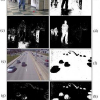Free Online Productivity Tools
i2Speak
i2Symbol
i2OCR
iTex2Img
iWeb2Print
iWeb2Shot
i2Type
iPdf2Split
iPdf2Merge
i2Bopomofo
i2Arabic
i2Style
i2Image
i2PDF
iLatex2Rtf
Sci2ools
CVPR
2008
IEEE
2008
IEEE
Kernel-based learning of cast shadows from a physical model of light sources and surfaces for low-level segmentation
In background subtraction, cast shadows induce silhouette distortions and object fusions hindering performance of high level algorithms in scene monitoring. We introduce a nonparametric framework to model surface behavior when shadows are cast on them. Based on physical properties of light sources and surfaces, we identify a direction in RGB space on which background surface values under cast shadows are found. We then model the posterior distribution of lighting attenuation under cast shadows and foreground objects, which allows differentiation of foreground and cast shadow values with similar chromaticity. The algorithms are completely unsupervised and take advantage of scene activity to learn model parameters. Spatial gradient information is also used to reinforce the learning process. Contributions are two-fold. Firstly, with a better model describing cast shadows on surfaces, we achieve a higher success rate in segmenting moving cast shadows in complex scenes. Secondly, obtaining...
Background Surface Values | Cast Shadows | Computer Vision | CVPR 2008 | Model Describing Cast | Scene 3d Geometry | Shadows Induce Silhouette |
| Added | 12 Oct 2009 |
| Updated | 28 Oct 2009 |
| Type | Conference |
| Year | 2008 |
| Where | CVPR |
| Authors | André Zaccarin, Nicolas Martel-Brisson |
Comments (0)

